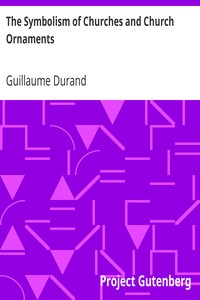| Author |
Durand, Guillaume, 1230?-1296 |
| Translator |
Neale, J. M. (John Mason), 1818-1866 |
| Translator |
Webb, Benjamin, 1819-1885 |
| Title |
The Symbolism of Churches and Church Ornaments
A Translation of the First Book of the Rationale Divinorum Officiorum
|
| Credits |
Produced by Don Kostuch, from scans obtained from Internet Archive.
|
| Summary |
"The Symbolism of Churches and Church Ornaments" by Guillaume Durand is a theological treatise that delves into ecclesiastical architecture and symbolism, likely written in the late 13th century during the medieval period. The book serves as a translation of the first book of Durandus's original work, "Rationale Divinorum Officiorum," and explores the significance behind architectural forms and ornaments in Christian churches. It aims to elucidate how these structures reflect deeper spiritual meanings, an area that has garnered considerable interest among church scholars and ministers. The opening portion of the work presents a comprehensive introduction to the author's aims and contextual background. It discusses the historical applicability of symbolism in church design, arguing that church architecture is not merely utilitarian but laden with sacramental meaning—a principle essential for understanding the rich tapestry of Christian worship. The text suggests that the nuances of architectural design, such as orientation and structural details, were influenced by the necessity to embody Christian doctrine symbolically. Furthermore, it mentions the lack of modern architects' adherence to these rich traditions and stresses the need for a revival of this historical understanding in contemporary church building practices. (This is an automatically generated summary.)
|
| Language |
English |
| LoC Class |
BV: Philosophy, Psychology, Religion: Christianity: Practical theology, Worship
|
| Subject |
Christian art and symbolism
|
| Subject |
Church architecture
|
| Category |
Text |
| EBook-No. |
43319 |
| Release Date |
Jul 27, 2013 |
| Copyright Status |
Public domain in the USA. |
| Downloads |
214 downloads in the last 30 days. |
|
Project Gutenberg eBooks are always free!
|

